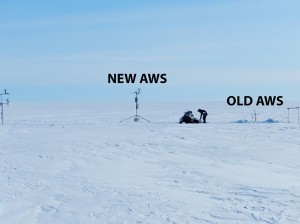The FirnCover research team arrived safely via snowmobile at KAN-U, their first work site this campaign season. The 67 km (41.6 mi) journey from “home base” camp, Dye-2, took about 4 hours without any major difficulties. Upon arrival, it was discovered that Mike’s firm compaction tower was still standing with no apparent physical damage despite its data transmission failure since September 2015. The first order of business today will be to diagnose and repair the transmission problem. They plan to spend 3 working days here then head back to Dye-2 to resupply and continue east to the EKT station.
Other tasks laid out for the day include:
- Drill a 16-20 m (52.5-65.6 ft) core to obtain the latest stratigraphy structure since the last melt season and install a new compaction instrument to wire to the existing tower
- Remove old IMAU (Institute for Marine and Atmospheric Research)
automatic weather station (AWS) - Maintenance of GEUS (Geological Survey of Denmark and Greenland) weather station
- Permeability experiments – more details about this here
- If time permits, will utilize skis to run a spectrometer around a 3 sq km (1.16 sq mi) area overlapping several MODIS satellite pixels to measure snow albedo (snow reflectance). The goal is to ground truth reflectance (albedo) with current MODIS satellite data.

Weather stations at KAN-U. Replacing old AWS tower with new one. Photo courtesy Achim Heilig, ACT 2015
Temperatures are alarmingly high at this point in the season. Initial shallow digging about 10-20 cm (4-8 in) under the surface has revealed 1-3 cm (0.5-1.5 in) thick refrozen ice lenses formed from the recent melt the last couple of weeks. If temps continue to rise, there are concerns about whether drilling is possible – and logging cores is very difficult if they start to melt. They may need to drill cores in the early morning hours and bury them in the snow to keep them from melting before getting them processed and logged.
The unprecedented melting this early in the field season is definitely contributing to a unique set of challenges this team has not yet encountered.
